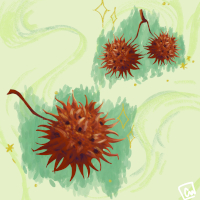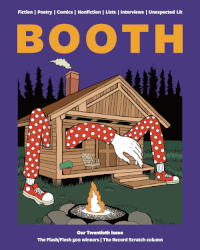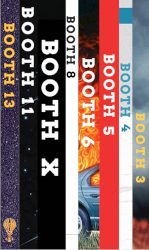“Do we test our alarms?”
“Of course we do,” I lie.
Page Nine: If the room is full of smoke. . ..
Oh, if only real life came with words written in the air!
“Smoke can kill!” it says on this page, right in the midst of a great big cloud of smoke. Doesn’t get much clearer than that.
We are back down to one dinosaur here. I think it’s the grown-up from the last page, though he has his glasses off
now. But he’s got the same polka-dot shirt and those bumps down his spine. And he is kind of throttling himself. That’s what it looks like to me, anyway. I think the author’s intention was probably to show that he is choking from the smoke, but in fact it looks as though he is choking himself. Which raises a good question. The whole matter of what one would do in this situation. Would it be better, I wonder, to wait there to burn to death, or simply to throttle oneself and call it a day?
And I’m wondering too what happened to his kid. There’s a hell of a lot of smoke on this page. The kid may be hidden by it. Or maybe he got away. Maybe they have a meeting place (the big tree? Sam’s porch?) and the kid is there waiting for his dad. It doesn’t seem likely though. So, what with the child’s whereabouts unknown and the adult wringing his own neck, it isn’t a very happy scene.
“This is pretty intense,” I say. “Pretty serious stuff for kindergarten. In real life . . .”
“He should be crawling on the floor,” my daughter says. But until I turn the page I have no idea what she means.
Page Ten: Crawl on the floor.
Ah, yes! Words to live by.
Kidding aside, the illustration makes it pretty clear that this dinosaur—the same one from the last page, though my daughter has changed his color scheme from green to blue—has made a good choice by crawling on the floor. He has saved himself. If only himself.
This is made clear to me, the reader, in two different ways. I am, as we say, both shown and told. The showing part is the big smile on his face. A real shit-eating grin. He’s a happy camper. Pleased as punch. Everything is going to be fine.
And then, I am also told that he’s right to be so happy by the way the sky above him is shaded with cross-hatching and labeled “smoke,” while the air around his head is clear and has written on it, plain as day, the words “good air." Obviously, he has made an excellent choice.
To my delight it’s evident that my daughter too has understood this page. Completely ignoring the word “smoke,” she has covered the lettering that says “good air” with a veritable rainbow of magic marker dots. And I know what that means. It means that she gets it. She understands. In the event of a fire, she will crawl on the floor. She'll save herself. She’ll be okay.
“That’s all there is, Mommy. That’s what we learned today.”
“It looks like you learned some good stuff,” I say. “You really did a great job with this book.”
But after saying it, I wonder what exactly she has learned.
Because looking at this page, if you didn’t know any better, you really would believe it was going to be fine. All of it. The world looks like a pretty safe place for dinosaurs—as long as they follow a few simple rules. That last dinosaur looks as though he hasn’t a care in the world. He must be pretty certain that his kid got out okay. I almost believe it myself. The dinosaurs are going to be just fine.
But there’s something else still bothering me. A reason I can’t quite relax. “I do wonder what happened to little Max,” I say.
My daughter takes the book from my hands and stands. “I told you that already, Mommy. Max got burned.” She starts skipping toward the door. “Max is dead, Mommy. Max is dead,” she chants, the red plastic hat slipping from side to side on her head. “Max is dead. Max is dead. Max is dead.”
“Where are you going?” I ask.
But she’s already too far away to hear my voice.



